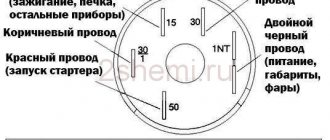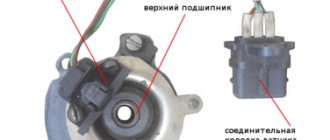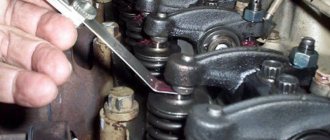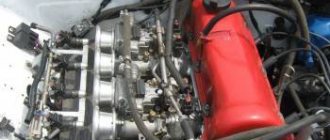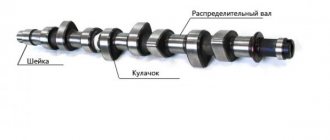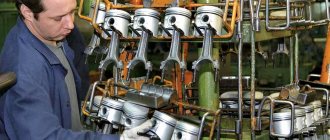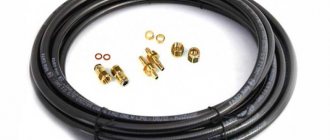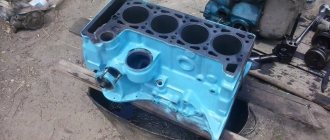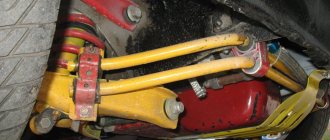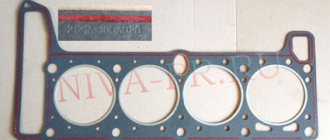Once the engine has been repaired, it needs to be installed on the car. The engine is installed on a half-assembled engine, it does not have a head. To install the engine without a lift, due to its weight, you will need only two people, but three are better; the task of two is to release the engine, and the third will direct it to the box shaft. In order not to suffer, trying to get the engine onto the gearbox shaft, it will need to be fixed, the box will need to be lifted with a jack.
In this position, the box will be fixed, as a result it will be easy for the engine to get onto the box shaft. The engine must be lowered slowly, since it is not very easy to direct it onto the input shaft; only after the shaft is in the basket is the engine lowered completely onto the box.
When installing, you need to carefully ensure that the engine fits smoothly into the box, there should be no distortions, only then the shaft fits evenly into the crankshaft bearing and clutch disc.
If everything is done correctly, installation takes about 2-3 minutes. Now we gradually lower the jack and make sure that the engine mounts rest on the cushions. We screw the box to the engine, the generator, the starter, and connect the stove pipe to the pump. Now all that remains is to install the block head.
What engines were the first VAZs equipped with?
“Kopeykas” were equipped with two types of power units: 2101 and 21011. The design of the first was borrowed from the Italian Fiat-124. But this was not a copy, but a real improved version, although the camshaft was modernized. Unlike the Fiat, in which it was located at the bottom of the cylinder head, in the VAZ 2101 the shaft was located at the top. The working volume of this engine was 1.2 liters. It was capable of developing a power of 64 hp. s., which was plenty at that time.
The design of the “penny” engine was borrowed from Fiat
The VAZ 2101 engine differed from its predecessor in volume, which increased to 1.3 liters, and, accordingly, in the size of the cylinders. This did not lead to a significant improvement in power characteristics, however, it was this unit that became the prototype for subsequent modifications, namely 2103 and 2105.
The VAZ 2101 engine has four cylinders arranged in one row
Table: main characteristics of VAZ 2101 and VAZ 21011 engines
| Positions | Indicators | |
| VAZ 2101 | VAZ 21011 | |
| Type of fuel | Gasoline A-76, AI-92 | Gasoline AI-93 |
| Injection device | Carburetor | |
| Cylinder block material | Cast iron | |
| Cylinder head material | Aluminium alloy | |
| Weight, kg | 114 | |
| Cylinder arrangement | Row | |
| Number of cylinders, pcs | 4 | |
| Piston diameter, mm | 76 | 79 |
| Amplitude of piston movement, mm | 66 | |
| Cylinder diameter, mm | 76 | 79 |
| Working volume, cm3 | 1198 | 1294 |
| Maximum power, l. With. | 64 | 69 |
| Torque, Nm | 87,3 | 94 |
| Compression ratio | 8,5 | 8,8 |
| Mixed fuel consumption, l | 9,2 | 9,5 |
| Declared engine life, thousand km. | 200000 | 125000 |
| Practical resource, thousand km. | 500000 | 200000 |
| Camshaft | ||
| location | top | |
| valve timing width, 0 | 232 | |
| value of the exhaust valve advance angle, 0 | 42 | |
| intake valve retard, 0 | 40 | |
| diameter of seals, mm | 56 and 40 | |
| width of seals, mm | 7 | |
| Crankshaft | ||
| Neck diameter, mm | 50,795 | |
| Number of bearings, pcs | 5 | |
| Flywheel | ||
| outer diameter, mm | 277,5 | |
| bore diameter, mm | 256,795 | |
| number of ring teeth, pcs | 129 | |
| weight, g | 620 | |
| Recommended Engine Oil | 5W30, 15W40 | 5W30, 5W40, 10W40, 15W40 |
| Engine oil volume, l | 3,75 | |
| Recommended Coolant | Antifreeze | |
| Coolant quantity, l | 9,75 | |
| Timing drive | Chain, double row | |
| Cylinder operating order | 1–3-4–2 | |
Cold method of pressing a finger into a VAZ connecting rod. Video
The crankshaft has been installed, now we need to knock out the old pistons and install new repair pistons on the connecting rods. It is good to knock out the piston pins on a stump; drill a hole in the stump in advance, or knock it out with a chisel; the piston pin will be knocked out into this hole. It is advisable to knock out the finger with a special beard, or a round piece preferably with a diameter of 21 mm, and a heavy hammer. The piston pins are knocked out when cold; there is no need to heat them up.
Photo. Preparing pistons for installation on connecting rods.
Now we need to install new pistons on the connecting rods, you can install the pistons as is without modification, but I advise you not to be lazy and modify the pistons. First, chamfer the skirt using a sharpener or a file as shown in the photo, second, drill a hole in the piston skirt on both sides as shown in the photo.
Engines with modified pistons are much faster and more economical, since oil flows through the hole between the piston and cylinder skirt and reduces friction. Also, modified pistons do not suffer much if the engine accidentally overheats. The hole in the piston skirt used to be drilled 6mm, now it’s 14mm, so with a 14mm hole the engine turns out even faster.
What kind of motor can be installed on a “penny” instead of the standard one?
One of the main types of car tuning is improving the car engine. VAZ 2101 engines are an unplowed field in this sense. Some craftsmen install turbines on them in order to increase power and traction characteristics, others change the crankshaft and bore the cylinders, and still others simply change the engine to a more powerful one. But here it is important not to overdo it, because the car body is designed for certain loads, exceeding which can seriously harm the entire car.
Among the popular options for replacement, it is worth considering only power units that are similar in design and performance. For a penny, without any problems, you can install a 1.6 or 2.0 liter gasoline engine from the same Fiat Argenta or Polonaise.
The engine from Fiat Argenta can be installed on any classic VAZ without any special modifications
You can try the same engine from Renault Logan or Mitsubishi Galant, if you install them together with a gearbox. But the best option is a power unit from subsequent modifications of VAZs. These could be VAZ 2106, 2107, 2112 and even 2170. The engines from these cars are suitable both in size and in mounting to the gearbox.
More about the VAZ 2101 gearbox: https://bumper.guru/klassicheskie-modeli-vaz/kpp/korobka-peredach-vaz-2101.html
Adjustment of valves
You need to start adjusting the valves from the fourth cylinder, the mark on the camshaft sprocket should be opposite the camshaft mark, so we will adjust the 8th and 6th valves, then turn the crankshaft 180 degrees, then we can adjust the 4th and 7th valves, turn the crankshaft another 180 degrees 1 and 3, to adjust 5 and 4, turn another 180 degrees.
You can buy a feeler gauge designed for adjusting valves, this feeler gauge needs to be inserted between the camshaft and the rocker, loosen the nut by seventeen, and with a wrench of 13 you need to move the rocker so that it slightly clamps the feeler gauge. Now we slightly tighten the nut to seventeen, and with a wrench to 13 we loosen the rocker until the feeler gauge moves not hard but not easily, and now we tighten the nut to seventeen, if the feeler gauge tightens, the adjustment must be repeated. In my opinion, you don’t need to adjust the valves well right away, the point is that when you start the engine, it will run for a couple of minutes, the valves will clearly sit in their places, and you will have to adjust them again.
VAZ 2101 engine malfunctions and their symptoms
No matter how reliable the power unit of the “penny” is, it can also sometimes be capricious. The main signs of its malfunction are:
- inability to start;
- unstable operation at idle, tripping;
- reduction in traction and power characteristics;
- overheat;
- extraneous noise (knocking, clattering);
- the appearance of white (blue) exhaust.
Naturally, any of the listed symptoms cannot clearly indicate a specific malfunction, so let's look at them in more detail in the context of possible breakdowns.
The engine won't start at all
If, when you turn on the ignition and turn the key to the position at which the starter is turned on, the latter works, and the power unit shows no signs of life at all, this may be evidence of failure:
- ignition coils;
- distributor;
- breaker;
- ignition circuits;
- fuel pump;
- carburetor
If such a symptom is detected, you should not immediately change any of the ignition system components or disassemble the carburetor. First, make sure that voltage from the battery is supplied to the coil, distributor, distributor, and spark plugs. After this, you can begin diagnosing the fuel pump and carburetor.
Unstable operation at idle
In this case, the malfunction can also be caused by problems in two systems: power and ignition. Typical breakdowns accompanied by this symptom include:
- failure of the carburetor solenoid valve;
- clogging of the fuel filter at the inlet to the carburetor;
- clogged fuel or air jets;
- violation of regulation of the quality and quantity of the fuel-air mixture;
- malfunction of one or more spark plugs;
- burning of the contacts of the ignition distributor, distributor cap, slider;
- breakage of the current-carrying core (insulation breakdown) of one or more high-voltage wires.
Here, as in the previous case, it is better to start searching for the problem by checking the ignition system.
Reduced engine power
The power unit may lose its power characteristics due to:
- fuel pump malfunction;
- clogged fuel filter or fuel line;
- violation of regulation of the quality of the fuel-air mixture;
- increasing the gap between the breaker contacts;
- incorrect adjustment of valve timing or ignition timing;
- wear of piston group elements.
If you detect a decrease in the power and traction characteristics of the power unit, first check whether the timing marks of the gas distribution mechanism match, and also whether the ignition timing is set correctly. Next, you should make sure that the gap between the distributor contacts is adjusted correctly. After this, you can start checking the fuel pump, filter and carburetor. If a drop in engine power is accompanied by thick white smoke from the exhaust pipe, the appearance of an oil emulsion in the air filter housing is a clear sign of wear or damage to the piston parts.
Overheat
A violation of the normal temperature regime can be identified by observing the behavior of the arrow on the temperature indicator located on the vehicle’s instrument panel. When overheated, it moves to the red sector of the scale. In more complex cases, the coolant simply boils. Under no circumstances should you continue driving with such a malfunction. This will inevitably lead, at a minimum, to burnout of the cylinder head gasket.
Engine overheating can be caused by:
- thermostat malfunction (blocking the movement of fluid through the cooling radiator);
- breakdown of the water pump (pump);
- low level of coolant in the system (depressurization, leakage of coolant);
- inefficient operation of the radiator (clogged tubes, external lamellas);
- broken radiator fan drive belt.
Having discovered that the car’s engine has begun to overheat, the first thing you need to do is check the coolant level in the expansion tank. Next, you need to determine whether the thermostat opens to a large circle. To do this, just touch the radiator pipes. With a warm engine they should both be hot. If the top one is hot and the bottom one is cold, the thermostat is faulty and needs to be replaced.
It is almost impossible to determine if the pump is faulty without dismantling it, so it is better to leave this option for last. But the performance of the fan is easy to determine. The “penny” has a permanent drive. Its impeller is driven by a V-belt from the crankshaft pulley. By the way, this belt also ensures the operation of the water pump, so if it breaks, two components of the cooling system will fail at once.
Extraneous noise in the engine
A car engine itself is a rather complex mechanism that produces many different sounds during operation. It is impossible for an uninitiated person to determine by ear a malfunction of the power unit, but a specialist, even without additional equipment, can tell you which sound is unnecessary and what kind of breakdown it indicates. For the VAZ 2101, the following extraneous sounds can be distinguished:
- valve knocking;
- knocking of main or connecting rod bearings;
- clatter of piston pins;
- loud rustling of the timing chain.
Valve knocking can occur due to increased clearance in the valve mechanism, wear of the valve springs, and wear of the camshaft cams. A similar problem is solved by adjusting the valves, replacing springs, restoring or replacing the camshaft.
The crankshaft main and connecting rod bearings may also make knocking noises. Such a malfunction may indicate low oil pressure in the system, increased clearance between the bearings and connecting rod journals, or severe wear of the bearings themselves.
Piston pins usually knock for one reason - incorrectly set ignition angle. Their knocking indicates that the fuel-air mixture ignites too early, which causes detonation in the combustion chambers. It is enough to “delay” the ignition a little by turning the distributor clockwise, and the problem will disappear.
The timing chain cannot help but rustle while driving, but an excessively loud sound is a sign of either stretching or a broken damper. Such a breakdown can be eliminated by replacing the damper or tensioner shoe.
Find out more about the VAZ 2101 ignition system: https://bumper.guru/klassicheskie-modeli-vaz/elektrooborudovanie/zazhiganie/kak-vystavit-zazhiganie-na-vaz-2101.html
Thick white exhaust
A serviceable engine practically does not smoke in dry weather. In frost or rain, the exhaust becomes noticeably denser due to condensation. This is absolutely normal. But if thick white (in some cases bluish) smoke comes from the exhaust pipe, regardless of weather conditions, most likely there is wear on the piston rings, and perhaps on the pistons themselves and the cylinder walls. In this case, the oil enters the cylinders and burns, and the oil that does not burn is expelled through the carburetor into the air filter housing. It is the burnt grease that creates that white smoke. In addition, when parts of the piston group wear out, exhaust gases can enter the lubrication system, creating excess pressure there. As a result, oil may even leak out through the dipstick hole. There is only one way out - a major overhaul of the engine.
But that's not all. White exhaust is also a sign of cylinder head gasket damage, in which coolant circulating in the cooling jacket enters the combustion chambers. This malfunction is almost always accompanied by exhaust gases entering the expansion tank. So, if you see white smoke, don’t be too lazy to look into the tank. The smell of the exhaust and air bubbles will point you in the right direction to find the problem.
How to determine a good camshaft?
Typically, a factory camshaft is sold in packaging, while a fake one is sold without packaging or wrapped in paper.
What you need to pay attention to when buying a camshaft, the first package, the second, the limiter must be screwed on, the camshaft must sit tightly in the bed, you can knock on the camshaft bed with your fist, if you hear a metallic click, then the camshaft is loose and dangling in the bed. Be sure to pay attention to the oil supply channels to the camshaft cams (the correct channel is shown in the photo) all channel holes must be exactly in the center with a chamfer
If you see holes on the camshaft that are mixed from the center and without chamfers, it means that it was made by artisans in underground workshops, or it is a factory defect.
Photo. Factory camshaft, the arrow shows the correct oil supply channel. Below is a photo of the factory packaging of the camshaft.
Gorobinsky S.V.
A few important notes
In fact, there are quite a lot of options for such tuning. However, before choosing something specific, it is worth understanding a number of fundamental rules.
The engine compartment space on the VAZ 2101 is quite small. You can, of course, fit almost any engine into it (unless it definitely won’t fit from a dump truck), but for many engines you will have to cut the body - and this is a completely different amount of work and costs, not everyone can handle this without the involvement of outside specialists with special tools .
The power of the new engine should not greatly exceed the capabilities of the factory one. This is if, in addition to installing it, you don’t want to deal with strengthening its body and replacing half of the other components. Honestly, in this case, the cost of re-equipment will be higher than the residual price of your “penny”.
It is advisable to take engines from rear-wheel drive models so as not to have to replace or adapt the transmission, brakes and suspension.
In most cases, it is still necessary to change individual parts along the way and modify the joints of the old and the new. But your task is to reduce such variations to a minimum, unless tinkering with a car is not your hobby.
Ways to repair a hole with damaged threads:
- Larger thread cutting.
- Damaged holes can first be welded, and then a hole of the required diameter can be drilled and threaded.
- Restore using repair. kit - thread restoration (FAT). A thread former is a tool for repairing bad threads in various systems: fuel supply, lubrication, cooling, transmissions, cylinder head cover.
- Using screws.
- Using spiral threaded inserts.
The most rational way to restore a hole with damaged threads is to use threaded inserts. The insert looks like a spring spiral made of wire with a rhombic cross-section, on one side of which a technological lead is bent, with the help of which the insert is wrapped into the hole.
Repair using a spiral insert by drilling out the defective hole to the required size, then cutting a thread to the size of the spiral insert, then screwing in the spiral insert and breaking off the driver along the notch. A special kit with spiral inserts is sold, which includes: inserts, drills, taps, tools for screwing in the inserts.
Causes
There are several most common reasons why a car owner has to remove the engine from his car.
| Cause | Peculiarities |
| Major renovation | In the event of a serious accident or as a result of wear of key engine elements, it will not be possible to restore its functionality without a removal procedure. Therefore, they resort to dismantling the engine |
| Replacement | It’s not uncommon for VAZ 2109 owners to think about replacing the standard factory engine with a more efficient, powerful power unit. This is a serious step, where dismantling is one of the initial stages |
| Finalization | If there is no opportunity or desire to change the engine, some simply modify the existing one. Tuning can be quite complex, involving the need to completely remove the engine from the engine compartment |
Regardless of the reasons, you need to remove the engine carefully, following a clear sequence of your actions. Decide in advance whether you will dismantle the engine together with the gearbox or without removing it.
Maintenance
Considering the design of the internal combustion engine, the manufacturer recommends the following maintenance schedules:
| Maintenance object | Time or mileage (whichever comes first) |
| Valve train chain | replacement after 100,000 km |
| Battery | 1 year/20000 |
| Valve clearance | 2 years/20000 |
| Crankcase ventilation | 2 years/20000 |
| Belts that drive attachments | 2 years/20000 |
| Fuel line and tank cap | 2 years/40000 |
| Motor oil | 1 year/10000 |
| Oil filter | 1 year/10000 |
| Air filter | 1 – 2 years/40000 |
| Fuel filter | 4 years/40000 |
| Heating/Cooling Fittings and Hoses | 2 years/40000 |
| Coolant | 2 years/40000 |
| Oxygen sensor | 100000 |
| Spark plug | 1 – 2 years/20000 |
| Exhaust manifold | 1 year |
With timely cleaning, the lubrication, cooling and fuel supply system operates longer without major repairs.
